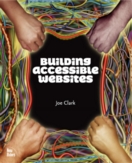![[joeclark.org: Web AccessiBlog] joeclark.org: Web AccessiBlog](accessiblog5.gif)
No longer updated
AccessiBlog topics
Building Accessible Websites
now available
 |
The AccessiBlog is one of five Joe Clark Weblogs (Axxlog, Bookblog, fawny.blog, NUblog).
You are here: joeclark.org
> Captioning and media access
>
Web AccessiBlog > Research
Updated 2002.10.12
Research
A few academic-style research papers are available online.
- Characteristics of Web Pages for Optimal Non-Visual Use: Working Online Bibliography (2002.10.12)
- How Assistive Software Supports Web Accessibility: “Among Web accessibility experts and Web developers trying to make their sites accessible, numerous questions have been raised concerning the way various assistive software treat or simply ignore the accessibility information added to pages. Not surprisingly, developers are rather unmotivated to bring modifications that will hardly be, if at all, considered by the assistive software. And when the accessibility information is treated, they would like to understand how it will actually be rendered to users in order to adjust their methods to attain the desired results” (2002.06.10)
- Accessible rich media: Strategies and solutions for multimedia users and authors (Andrew Kirkpatrick, CSUN 2002; 2002.04.15)
- Challenges Of Accessible Web Design: Standards, Guidelines, And User Testing (John M. Slatin, Institute for Technology and Learning (2002.04.15)
- Conducting Usability Testing with Computer Users Who Are Blind or Visually Impaired (Elaine Gerber, American Foundation for the Blind; 2002.04.15)
- Designing an Accessible Library Catalogue for the Web (Mitake Holloman Burts, Keystone Systems, Inc.; 2002.04.15)
- The Accessibility Internet Rally: How to Rally Your Community Around Web Accessibility (Sharron Rush, Knowbility, Inc.; 2002.04.15)
- What You Need to Know About Section 508 of the Rehabilitation Act (Taymour Ravandi, Protection & Advocacy, Inc.2002.04.15)
- Web Services and User/Device Profiling for Accessible Internet Services Provision (Carlos A. Velasco and Yehya Mohamad; 2002.04.15)
- Web Content Transcoding For Voice Output (Hironobu Takagi and Chieko Asakawa; 2002.04.15)
- Using MAGpie 2.0 (Media Access Generator, version 2.0) from NCAM (Geoff Freed; 2002.04.15)
- Disabled access and categorisation: “Do disabled users categorize information differently, or can all the important access issues be taken care of in the implementation?” (2001.12.08)
- Universal Design and the Grid: “The Grid is an attempt to expand the possibilities for human benefit from distributed and remote computation by dint of architecture of common practices.... This potential could be an engine for making information services more broadly available and accessible to a wider range of people, in particular people with disabilities. But this outcome requires attention to certain design issues early in the process and from the ground up in the architecture. This white paper collects lessons learned from the area of Disability Access to Information Technology and Telecommunications. For example, one of the lessons learned is that the requirements of access by people with disability and access from small mobile devices are very similar. Thus paying attention to scalability issues in the characterization of services and resources will help people with screen readers, but not just people with screen readers” (2001.12.08)
- CC/PP: “CC/PP stands for Composite Capabilities/Preferences Profiles, and is a way to specify what exactly a user agent (Web browser) is capable of doing. This allows for sophisticated content-negotiation techniques between Web servers and clients, to produce optimized XML-based markup for display and use on a wide variety of Web user agents.” In other words, you could set up your browser/screen reader to tell compliant Web sites to move navigation and everything other than content to the end of the document rather than the beginning, to use but one example; see “CC/PP, Usability for PWDs, the Edapta model, and You” (2001.12.08)
- Pre-testing for user-profiles to enhance accessibility of digital cartography for the partially sighted: “The aim of this study was to specify a test module (with visual function tests), of which the results can be used to adjust sotware to individual visual perception. The test results of the module will be stored in a user profile. Software can then use this information to automatically adjust its user interface and content to the individual user-profile, thus making it more easily possible for partially-sighted to work with the same software as their sighted counterparts” (2001.12.08)
- Why People Can’t Use E-Learning: “Unusable interfaces will cost E-learning companies billions of dollars in lost revenues because many people won’t be able to use their products. The paper looks at the current state of usability and accessibility in E-learning and provides practical insights and direction on good practice, as well as outlining the business benefits” (2001.09.22)
- Nicky Danino: Making the Internet More Accessible for Users of Speech and Other Browsing Technologies (ongoing Ph.D. research; 2001.06.10)
- The Towel Project: Not clear if Towel is an acronym or not. In any event, several research papers (in PDF) are available (2001.03.26):